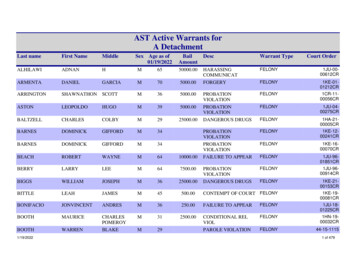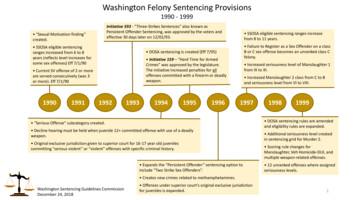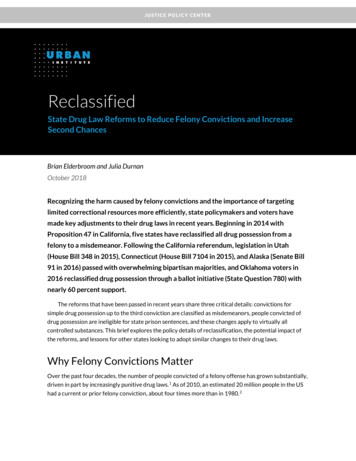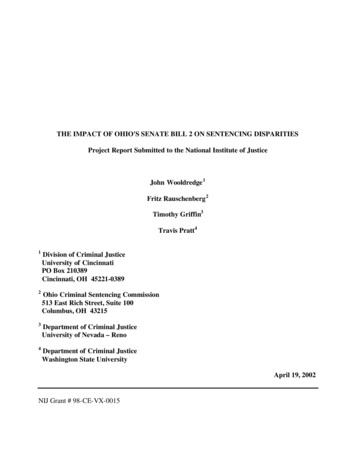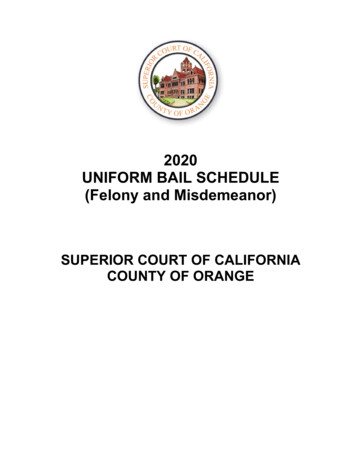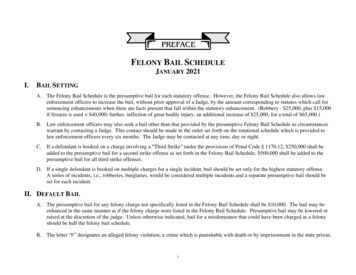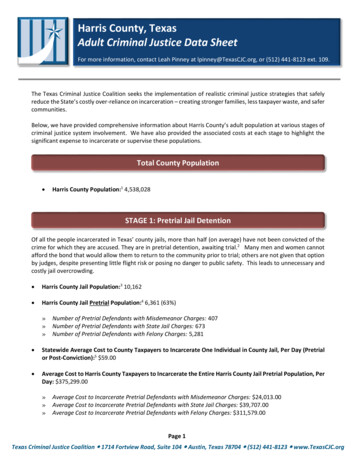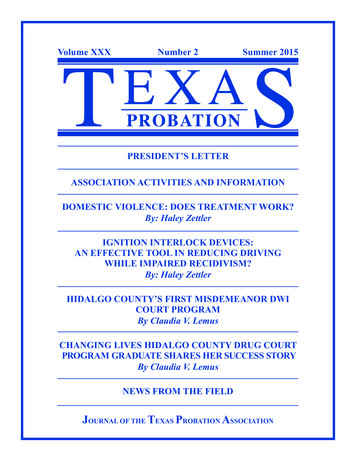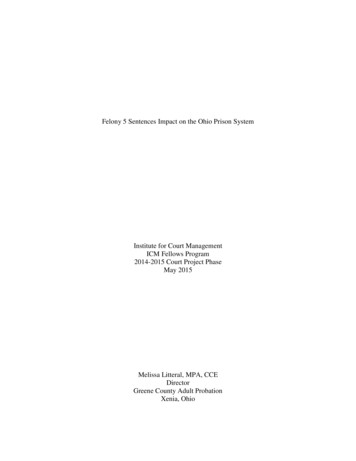
Transcription
Felony 5 Sentences Impact on the Ohio Prison SystemInstitute for Court ManagementICM Fellows Program2014-2015 Court Project PhaseMay 2015Melissa Litteral, MPA, CCEDirectorGreene County Adult ProbationXenia, Ohio
AcknowledgmentsI had many reservations about participating in the Fellows Program. The first reservationwas that it had been years since I had written any paper. The second reservation was when andhow would I get this accomplished? After discussing this with my husband, he reminded mehow much I liked participating in the ICM classes and this really was the final level of theprogram. I want to thank my husband again for being so supportive and for giving up countlessweekends so I could complete this project. I would be remiss if I did not thank the HonorableStephen A. Wolaver. Judge Wolaver has always supported me as the Director of the ProbationDepartment. He has provided great insight into the legal system and has promoted my growthand development by recommending me for the Institute for Court Management Program. I alsowant to thank my staff, friends, colleagues, and the data processing staff. Finally, I must thankNicole Waters from the National Center for State Courts. Her expertise and guidance kept me ontarget, and her encouragement steered me to the finish line.i
Table of ContentsAcknowledgments . . . . . . . . . . . . . . . . . . . . . . . . . . . . . . . . . . . . . . . . . . . . . . . . . . . . .iTable of Contents . . . . . . . . . . . . . . . . . . . . . . . . . . . . . . . . . . . . . . . . . . . . . . . . . . . . .iiList of Figures . . . . . . . . . . . . . . . . . . . . . . . . . . . . . . . . . . . . . . . . . . . . . . . . . . . . . . . . ivList of Tables . . . . . . . . . . . . . . . . . . . . . . . . . . . . . . . . . . . . . . . . . . . . . . . . . . . . . . . . . vAbstract . . . . . . . . . . . . . . . . . . . . . . . . . . . . . . . . . . . . . . . . . . . . . . . . . . . . . . . . . . . . . 1Introduction . . . . . . . . . . . . . . . . . . . . . . . . . . . . . . . . . . . . . . . . . . . . . . . . . . . . . . . . .4Prison Overcrowding and the War on Drugs . . . . . . . . . . . . . . . . . . . . . . . . . . .5Probation (Community Control) Revocation . . . . . . . . . . . . . . . . . . . . . . . . . . . .7Sentencing Modality . . . . . . . . . . . . . . . . . . . . . . . . . . . . . . . . . . . . . . . . . . . . . .8Literature Review . . . . . . . . . . . . . . . . . . . . . . . . . . . . . . . . . . . . . . . . . . . . . . . . . . . . . 10HB 86: What It Did for Criminal Justice in Ohio . . . . . . . . . . . . . . . . . . . . . . . . . . 13Earned Credit . . . . . . . . . . . . . . . . . . . . . . . . . . . . . . . . . . . . . . . . . . . . . . . . . . . . 14Mandatory Drug Provisions . . . . . . . . . . . . . . . . . . . . . . . . . . . . . . . . . . . . . . . . . 14Judicial Release . . . . . . . . . . . . . . . . . . . . . . . . . . . . . . . . . . . . . . . . . . . . . . . . . .14DRC Judicial Release . . . . . . . . . . . . . . . . . . . . . . . . . . . . . . . . . . . . . . . . . . . . . 14Intervention in Lieu of Conviction . . . . . . . . . . . . . . . . . . . . . . . . . . . . . . . . . . . . . 15Methods . . . . . . . . . . . . . . . . . . . . . . . . . . . . . . . . . . . . . . . . . . . . . . . . . . . . . . . 24Findings . . . . . . . . . . . . . . . . . . . . . . . . . . . . . . . . . . . . . . . . . . . . . . . . . . . . . . . . . . . . 29Ohio Department of Rehabilitation and Correction . . . . . . . . . . . . . . . . . . . . . . . 32Probation Officer Survey. . . . . . . . . . . . . . . . . . . . . . . . . . . . . . . . . . . . . . . . . . 33Conclusions and Recommendations . . . . . . . . . . . . . . . . . . . . . . . . . . . . . . . . . . . . . 38ii
Conclusion 1: Non-Violent Lower-Level Felons . . . . . . . . . . . . . . . . . . . . . . . . 39Recommendation1: What It Takes to Decrease Prison Population . . . . . . . . . 39Conclusion 2: Substance Abuse Contributes to Ohio’s Prison Population . . . . 40Recommendation 2: Develop a Campaign on Substance Abuse . . . . . . . . . . . 40Conclusion 3: A Central Probation Repository for Probation Data . . . . . . . . . . 43Recommendation 3: Legislation Follow-Up on Probation Data . . . . . . . . . . . . 43Conclusion 4: Legislative Mandates Impacts Prison Overcrowding . . . . . . . .44Recommendation 4: Legislative Oversight . . . . . . . . . . . . . . . . . . . . . . . . . . .44Conclusion 5: Probation Revocation Impact on Prison Overcrowding . . . . . . . 45Recommendation 5: Local Jail Sentence . . . . . . . . . . . . . . . . . . . . . . . . . . . . . 45Conclusion 6: Substance Abuse Programs Model for Prison. . . . . . . . . . . . . . . 45Recommendation 6: Specific Prison for Substance Abuse . . . . . . . . . . . . . . . . 45Appendix A: Initial Communication with Survey Respondents . . . . . . . . . . . . . 47Appendix B: Judicial Questionnaire Survey on 5th Degree Felonies . . . . . . . . . 48Appendix C: Probation Officers Survey on 5th Degree Felonies . . . . . . . . . . . . 50Appendix D: Survey Questions for (DRC) . . . . . . . . . . . . . . . . . . . . . . . . . . . .52Appendix E: Summary of Judge Responses . . . . . . . . . . . . . . . . . . . . . . . . . . 53Appendix F: Summary of Probation Staff Responses . . . . . . . . . . . . . . . . . . . 54iii
List of FiguresFigure 1: Annual Drug Related Commitments . . . . . . . . . . . . . . . . . . . . . . . . . . . . . 19Figure 2: Geographical Representation of Respondents . . . . . . . . . . . . . . . . . . . . . 27iv
List of TablesTable 1: Ohio Estimated and Actual Incarceration Data. . . . . . . . . . . . . . . . . . . . . . . 13Table 2: 2013 5th Degree Felony Commitments Sentenced and CCV . . . . . . . . . . .22Table 3: Types of Sanctions Utilized for 5th Degree Felony Probationers . . . . . . . .33Table 4: Reasons Provided for Probation Revocations . . . . . . . . . . . . . . . . . . . . . .34Table 5: Evidenced Based Practices Utilized in Probation Supervision . . . . . . . . . .34Table 6: Greene County Percentage of 5th Degree Felony Convictions . . . . . . . . . .36v
FELONY 5 SENTENCES IMPACT ON THE OHIO PRISON SYSTEMMelissa LitteralAbstractThe United States represents 5% of the world’s population but 25% of the world’sprison population. Violent crime in America has decreased over the past 25 years by 51%, yetthe American prison population has continued to explode with low-level non-violent felons.Ohio has the 6th largest prison system in the United States and is at a cross roads with the prisonsystem because without significant change, the population will continue to rise. The OhioGeneral Assembly has worked to decrease the overall prison population by enacting legislationit hoped would assist in decreasing the prison population. This research paper explored thefollowing issues with regard to Ohio’s prison population. What impact, if any, has legislation introducing a 5th degree felony had on theovercrowding of Ohio’s prisons? What impact, if any, has there been on the prison population due to probationrevocations? Using best practices, what options are available in Ohio to decrease the prisonpopulation?In order to examine the Ohio prison system, it was important to look at the history ofOhio’s felony sentencing restructuring, starting with sentencing recommendations from theOhio Sentencing Commission and subsequent legislation. There have been two recentsignificant pieces of legislation passed in Ohio that address felony sentencing. The most recent1
sentencing legislation was House Bill 86 (HB 86), enacted September 2011. This legislationmade comprehensive changes to Ohio’s criminal justice sentencing guidelines.Prior to HB 86, the last comprehensive changes in Ohio were enacted in 1996, throughSenate Bill 2 (SB 2). This legislation assisted with sentencing reform and was to assist withovercrowding of Ohio prisons. One significant change as a result of SB 2 was the creation of anew felony tier, known as the 5th degree felony. This felony is the lowest level felony in thesentencing guidelines and has a maximum sentence of 12 months in prison. The questionremains as to the impact SB 2 had, if any, on the Ohio prison population, and in particular, theresult of legislative changes on prison sentences for defendants convicted of lower-levelfelonies (known as 4th and 5th degree felonies).To ascertain these impacts, statistical data was obtained from the Ohio Department ofRehabilitation and Correction (DRC) Bureau of Planning and Research. Surveys were providedto selected judges, probation officers and selected DRC staff. Interviews were conducted withtwo judges, two prosecutors, two members of DRC staff, the former Director of the OhioSentencing Commission, and a probationer facing revocation.The findings and statistical data obtained suggest that the 5th degree felony tier created bySB 2 has had a negative impact on the prison system. Based on Ohio prison data, on average,25% of each year’s intakes are for low-level non-violent offenders, many with substance abuseissues, although the survey results indicated willingness by judges to sentence 5th degree felonsto community control. The probation surveys indicated that probation officers are trained inevidenced-based practices to assist with changing offender behavior, which may lead moreoffenders to successfully complete probation, and possibly lead to a decrease in recidivism.However, the probation surveys also indicated that probation officers face higher and more2
difficult caseloads, including probationers sentenced to community control on 5th degreefelonies who have substance abuse issues - one of the reasons cited for an increase in probationrevocations. This suggests that adding the 5th degree felony into the sentencing guidelinesplayed a role in increasing the prison population, thus having a substantial financial impactupon the prison system and state budget.How can Ohio decrease the prison population? This can be partially accomplished bychanging what constitutes a prison sentence for non-violent 5th degree felonies. Additionally, itis important to recognize that data suggests that sending 5th degree felony probation violators toprison is not cost-efficient and does not correct the criminal behavior. Evidence-basedpractices, that focuses on rehabilitation of low-level non-violent felony offenders utilizingprogramming and reintegration to assist offenders with changing behavior while in the prisonsystem, is another step in the right direction. DRC-provided initiatives to assist with prisondiversion by keeping lower-level felonies in the community are another option. However, thesechanges alone will not correct prison overcrowding.There must be meaningful collaboration between the General Assembly, courts,probation, and the prison system on how offenders are sentenced to prison. If this could beaccomplished, it could decrease the percentage of lower-level felons sentenced to prison eachyear by 23 to 25 percent. This could yield a significant reduction on the prison population overtime. The cross roads at which Ohio finds itself provides an opportunity for the state to be aleader in decreasing prison overcrowding. By changing sentencing guidelines on 5th degreefelonies, the overall prison population will decrease, low-level offenders would be heldaccountable, and Ohio’s communities kept safer.3
Introduction“Crime is normal because a society exempt from it is utterly impossible.” 1In order to look at the prison population in the 21st Century, a moment is needed to reflectback to the early history of corrections, dating back to Babylonian and Sumerian Times. Manyhistorians view the Hammurabi Code 2 as the first recorded set of codes that held individualsaccountable by government. To redress wrongs in early times, varied and different punishmentswere provided to criminals. These punishments ranged from death, torture, imprisonment,mutilation, forfeiture of property, retaliation, and fines. Torture, mutilation and branding wereconsidered corporal punishment and used until the 19th century. 3 The imprisonment of offendersis considered a more modern penal practice, but the origins of punishment reveal that the sameissues with prisons, such as overcrowding are not new.The laws by which people in society are held accountable today in the United States arebroken down by federal, state and local statutes (codes). Today, prisons are the center ofpunishment and located throughout the United States; however it was not until the 1790’s thatthe first prison which held offenders long term was built in Philadelphia, Pennsylvania andbecame the prototype for the modern prison system. Ohio’s first state penitentiary was built inColumbus in 1813 just ten years after becoming a state. As the first institutions(penitentiaries/prisons) were built, prison overcrowding became an issue. Ironic, that in 2015,overcrowding and budget issues continue to play a predominant part in corrections. Thepenitentiary was originally used to house offenders who would reflect on their crimes and repent.1Durkheim E.qtd [Allen, H& Simonsen, Clifford].The Code of Hammurabi written about 1750 B.C.3Reckless, Walter C. (1969). The Crime Problem, p. 49724
Facilities today are where felons are incarcerated as punishment, although rehabilitation is also astrong focus of incarceration.In modern times, confinement is dictated by the severity of the crime and varies fromstate to state. A felony is a criminal offense punishable by death or incarceration in a state orfederal confinement for a period described by statute in a given jurisdiction, typically one year ormore in a prison. A felony is considered a more egregious act than a misdemeanor. Amisdemeanor is an offense usually punishable by incarceration in a local facility for a perioddescribed by statute in a given jurisdiction, typically limited to one year or less. 4Prison Overcrowding and the War on DrugsPresident Reagan’s war on drugs in the 1980’s had a significant impact on prisonovercrowding. A primary goal of the War on Drugs legislation was to arrest drug dealers andreduce access of drugs to drug users. There was little or no attention placed on the causes of druguse and/or social problems that lead to addiction, and at the time of this legislation there waslittle effort placed on treatment. 5 This “War” increased work load, and prison overcrowding forthe entire criminal justice system. Many drug dealers were arrested, convicted, and placed intothe prison systems across the United States. In 1980 prisons held an estimated 319,000 offenderswith over 1 million offenders on probation. 6 Since the war on drugs and the implementation ofharsher sentencing laws there has been 1.1 million low-level or non-violent prisoners added tothe United Stated prison population. In 2013, over 1.5 million offenders were held in prisons and4Allen, Harry E. & Simonsen, Clifford E. (1995). Corrections in America, An Introduction. pp.94 and 96.Allen, Harry E. & Simonsen, Clifford E. (1995). Corrections in America, An Introduction. p.73.6Glaze, L.E. & Herberman,E.J. (2011) Correctional Populations in the United States, (2012). Washington, D.C.:Bureau of Justice Statistics; Corrections: Key Facts at a Glance. Washington, D.C.: Bureau of Justice Statistics.55
over 3 million offenders on probation. 7 It appears that most felony charges today arise out of theoffenders desire to obtain drugs or acts committed under the influence of substances of abuse.Today, Ohio is the sixth largest state prison system. The Ohio prison system consists of28 institutions throughout the state of Ohio, which includes one Correctional Medical Center,with buildings dating from 1916 to 2000. The Ohio prison system is overly used and this is asystemic issue not just for Ohio, but for all states with increasing prison populations. One sourceof the increase in prison populations is that legislators do not want their constituents to think theyare not tough on crime. Since the 1980’s, several tough sentencing laws were enacted across theUnited States and Ohio. Those sentencing laws have created concerns when balancing the needfor public safety while seeing an increase in the cost for the operation of state correctionalfacilities.The Ohio General Assembly has worked to decrease the overall prison population byenacting legislation they hoped would assist in decreasing the prison population. The most recentsentencing legislation was House Bill 86 (HB 86) enacted September 2011. This legislationmade comprehensive changes to Ohio’s sentencing guidelines. Unfortunately, these new lawshave not resulted in the decreases expected by the legislation. Prior to the most recentlegislation, HB 86, the last comprehensive changes were enacted in 1996, known as Senate Bill 2(SB 2). This legislation was enacted to assist with sentencing reform and the overcrowding ofOhio prisons. One significant change in SB 2 legislation was the creation of a new felony tier,known as the 5th degree felony. This felony is the lowest level felony in the sentencingguidelines and has a maximum sentence of 12 months in prison. Prior to SB 2, Ohio had four7Chettiar, I.M. (2015, February 9).The Many Causes of America’s Decline in Crime. The Atlantic Magazine,Retrieved from any-causes-of-americas-decline-in-crime/385364/6
degrees of felonies. The question remains as to the impact SB 2 had, if any, on the Ohio prisonpopulation, and in particular, the result of legislative changes on prisons sentences for defendantsconvicted of lower level felonies (known as 4th and 5th degree felonies). This paper will explorewhat, if any, impact the introduction of the 5th degree felony has had on Ohio prisons.Additionally, this paper will explore whether probation revocations may have attributed to theincrease in the prison population. In Ohio, felony probation is also known as community control.Probation is defined as a court-ordered period of correctional supervision in the community,generally as an alternative to incarceration. In some cases, probation can be a combined sentenceof incarceration followed by a period of community supervision by way of judicial release.In 2013, Ohio prison commitments totaled 20,528 individuals. Out of this number 25%were drug offenses and over 23% were probation or community control violators (revocations)from low level 4th and 5th degree felonies. It is worth noting that since 2000, the number ofprison inmates using opiates upon intake into the prison system has risen 500%. 8 This increaseand the number of low level felony incarcerations and probation revocations indicate the numberof offenders who are drug users committing crimes for their addiction and probation violatorswho will not comply with orders of the Court.Probation (Community Control) RevocationOnce an individual has been placed on probation and fails to follow the conditions setforth under his/her probation conditions the probationer may face revocation. If a revocation isfiled, the probationer is entitled to a probable cause and evidentiary hearing. If the judgedetermines the probationer violated the conditions of probation, the probationer may becontinued on probation with additional conditions or sanctions, or the judge may impose a prison8Ohio Department of Mental Health & Addiction Services. (2014). [Press Release]. Retrieved fromhttp://mha.ohio.gov7
sentence. If the probationer is sent to prison for a 5th degree felony the prison sentence will be12 months or less, unless the defendant has multiple cases or charges, only then may he or shereceive a longer sentence.Possession of drugs, trafficking in marijuana, theft and receiving stolen property areexamples of 5th degree felonies with a maximum incarceration of one year in the state of Ohio.These felonies are non-violent felonies which tend to relate to drug use as previously noted.Sentencing ModalityIn Ohio, individuals can be sentenced to state prison for a 5th degree felony with less thana one year sentence. The individual may be incarcerated in a local facility (jail) while the case ispending if bond is not posted. Once the prosecution and defense complete negotiations, and thejudge makes his/her findings, the defendant may be eligible for a prison sentence. As anexample, an individual may have 90 days of jail time credit on a 5th degree felony with a 12month sentence. The 90 days would be subtracted from the 12 month sentence (jail time credit)and thus the defendant would be incarcerated in state prison for 9 months.When looking at the overall community control supervision modality of corrections inthe state of Ohio, there are an abundance of opportunities to work with probationers/offendersthrough community-based correctional programs as well as funding initiatives from the OhioDepartment of Rehabilitation and Correction to decrease recidivism by implementing programsto assist courts and probation on sending offenders to prison. For example, there are programsbased on outpatient treatment as well as other programs such as intensive supervised probation toassist offenders to stay out of the prison system. It should be noted that Ohio has re-entryprograms for those individuals leaving the prison system and a record low offender recidivismrate of 27.1 percent. One reason for the lower rate can be attributed to the 2009 court decision8
which removed nearly 2,500 people from supervision with the Adult Parole Authority. Otherfactors, including the continued use of evidenced-based practices, are also keeping the recidivismrate lower than the national average. 9 With all the opportunities provided one has to wonder,why are prisons overcrowded?It appears the history of prison overcrowding remains an issue in the present, and thequestion now is how to change the overcrowding issue for the future. This paper will explore thefollowing on prison populations in Ohio:1. What impact, if any, has the legislation introducing the 5th degree felony into thesentencing guidelines in 1996 played in the overcrowding of Ohio’s prisons?2. What impact, if any, has there been on the prison population by probationrevocations?3. Finally, with research data indicating best practices, what options are available in thestate to decrease the prison population?9Ohio Department of Rehabilitation and Correction. (2014). Ohio’s Record Low Offender Recidivism RateContinues to Decline [Press Release]. Retrieved from http:www.drc.ohio.gov/Public/press/press428.htm9
Literature ReviewThe United States has the highest prison population in the world according to theInternational Centre for Prison Studies.10 The United States houses over 25 percent of all prisoninmates on the planet. When you look at these statistics, what are criminal justice professionalsand legislatures doing about America’s prison population? As a country we spend four timesmore on prison incarceration than we do on educating our children. 11 The cost of operating thecountry’s prison population is not currently sustainable. For example, if you build more prisons,surely more individuals will be placed in the prison system. The cost to tax payers will continueto increase unless other measures are taken to find alternative ways to change the type ofoffenders being sentenced to prison. Specifically, the many offenders who are being sentencedto prison are non-violent, low-level felony offenders with major drug addiction issues andcriminal histories.In Ohio, the prison population has been debated by the General Assembly and otherpractitioners in the criminal justice system for years. Ohio has roughly a 1.5 billion dollar pricetag when it comes to operating state prisons. The average cost for housing Ohio inmates is 68.14 per day, or 24,870 per year per offender. 12 According to the Urban Institute, Ohio wasone of 10 states to build more prisons during the1980’s and 1990’s. This was during the “War onDrugs” and when the General Assembly was “tough on crime.” 13 When Ohio built new prisons,those prisons filled up with inmates, many of whom were non-violent felons.10Ziv,Stav. (December 22,2014) Report: America’s Prison Population Is Growing Again. Newsweek. Retrievedfrom em-numbers-29358311Prann, Elizabeth.( March 14,2011) States Spend Almost Four Times More Per Capita on Incarcerating PrisonersThan Educating Students, Studies Say. FoxNews.com. Retrieved from 7/12Sub S.B. 160, 129th G.A. November 26, 2012.13Kantor, S & Good, L.(April 292004) Urban Institute. Retrieved 0
Today the Ohio prison population is over 50,000 inmates, which exceeds the prisonsystems maximum capacity by almost 32%. In an effort to be forward thinking the GeneralAssembly in 1991 created the Ohio Sentencing Commission to assist and advise on sentencinglaws and prison overcrowding.The Ohio Sentencing Commission conducted significant research on the impact of felonysentencing in Ohio which encompassed sentencing, prison population, and probation in Ohio.The General Assembly instructed the Ohio Sentencing Commission to develop a sentencingpolicy by matching criminal penalties with available resources and by promoting a full range ofsentencing options to decrease prison overcrowding. “The commission’s task was to makerecommendations to provide relief for the Ohio prison system without compromising publicsafety.” 14 In an effort to revamp the prison crowding issue and simplify Ohio sentencing laws,the Commission recommended drastic changes to the sentencing guidelines and alsorecommended a new felony tier.Prior to the development of this new tier, Ohio had four tiers of felonies with multiple(12) variations of those felonies. 15 The four tiers of sentencing along with the increase in drugconvictions had contributed to the increase in the prison population. The sentencingcommission’s recommendations were prepared and the Ohio legislature passed the newsentencing guidelines known as Senate Bill 2 (SB 2) effective July 1, 1996. As with anyimplementation, the creation of the 5th degree felony sentence had an impact on prisons, localjails, and Ohio’s probation system. During Fiscal Year 1992, The Department of Rehabilitationand Correction average daily population was an average of 35,234 and had an average1415Ohio Criminal Sentencing Commission. (1993). A Plan for Felony Sentencing in Ohio.Ohio Criminal Sentencing Commission. (1993). A Plan for Felony Sentencing in Ohio.11
expenditure per inmate of 32.22 per day or 11,791.09 per year per offender. 16 Today, theaverage expenditure per inmate is 68.14 per day or 24,871.10. As of December 2014, the totalpopulation was 50,870.The Sentencing Commission’s report also forecasted prison population projections andreviewed the Ohio Department of Rehabilitation and Correction (DRC) prison populationforecast. Based on the report, the sentencing commission and DRC differed as to the baselineprojections which were “what would happen if no changes were made?” and “what implicationswould be imposed from the sentencing commission’s changes?” The baseline projections alsodid not, per the report, consider the impact of increased funding for intermediate sanctions thatwere proposed at the time. The report did consider the effect of the new Community-BasedCorrectional Facilities (CBCF’s) that were going online.There are currently 18 (CBCF’s) in the state of Ohio. These facilities were created as apartial response to the growing prison population. CBCF’s are residential programs that providecomprehensive programming addressing offender needs such as chemical dependency,education, employment, and family relationships. The intensity of programming in CBCF’ssignificantly impacts their cost per day, but results in high successful completion rates andpositive impacts on recidivism. 17 Table 1 below depicts some of the baseline projection from(DRC) and the Ohio Sentencing Commission (OCSC) along with the actual population data forthose years. 1816Ohio Criminal Sentencing Commission. (1993) A Plan for Felony Sentencing in Ohio.Ohio Department of Rehabilitation and Correction (2014) Retrieved from www.drc.ohio.gov/web/BCS 2014 FactSheet.pdf18Ohio Criminal Sentencing Commission. (1993) A Plan for Felony Sentencing in Ohio.1712
Table 1. Ohio Estimated and Actual Incarceration DataYear DRCOCSCConsensusActual1999 52,52846,48749,50846,8062000 54,58747,40350,99546,5372001 56,44448,18552,31545,2442002 58,06249,11553,58944,917As previously noted, Ohio’s prison population is over 50,000 inmates. This would clearlyindicate that while more prisons were built in the 1990’s and sentencing laws restructured, Ohiostill incarcerated more offenders than capacity permits. In 2011, as the prison population totaled50,627, and in response to the rising inmate population, the Ohio legislature enacted House Bill86 (HB 86).HB 86: What It Did for Criminal Justice in OhioA goal of HB 86 was to assist with keeping non-violent felony four and five offenders outof prison by making it mandatory that certain 4th and 5th degree offenders without a criminalhistory receive mandatory community control. Officials predicted in March 2012, there would besignificant declines in sentencings to prison tied to HB 86 reforms with a projected population of47,250 by July 2015. Unfortunately, present predictions still indicate an increase in the overallprison population as it may climb to 52,169. 19 The prison population for 2012 was 49,713, in2013 it was 50,419, and in 2014 the total prison population was 50,510.19Beyerlein, T. Bischoff L. & McCall K. (Oct 26, 2013) Prison Population, costs rise despite reforms. Dayton DailyNews. Retrieved from http://www.daytondailynews.com/news/prison-popul
This legislation assisted with sentencing reform and was to assist with overcrowding of Ohio prisons. One significant change as a result of SB 2 was the creation of a new felony tier, known as the 5th degree felony. This felony is the lowest level felony in the sentencing guidelines and has a maximum sentence of 12 months in prison. The question

